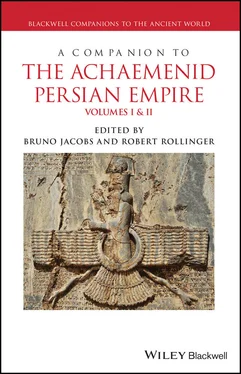Bruno Jacobs and Robert Rollinger
In 262 CE an army of Roman and Greek forces, led by the Roman Marianus (then probably governor of the Roman province of Achaea/Greece), gathered at Thermopylae to ward off an expected attack by Gothic invaders from the north. 1 In the wake of the military preparations to defend the pass, Marianus addressed the assembled Greek soldiers and fired up their emotions by referring to the achievements of their ancestors. This splendid episode was discovered only recently on a palimpsest in the Austrian National Library and convincingly identified as a fragment of the lost Scythica of the Greek author Herennius Dexippus (third century CE). The episode runs as follows:
(7) ‘O Greeks, the occasion of our preservation for which you are assembled and the land in which you have been deployed are both truly fitting to evoke the memory of virtuous deeds. For your ancestors, fighting in this place in former times, did not let Greece down and deprive it of its free state, for they fought bravely in the Persian wars and in the conflict called the Lamian war, and when they put to flight Antiochus, the despot from Asia, at which time they were already working in partnership with the Romans who were then in command. (8) So perhaps it may be good fortune, in accordance with the daimonion , that it has been allotted to the Greeks to do battle against the barbarians in this region (indeed your own principles of fighting the wars have turned out to be valid in the past). But you may take confidence in both your preparation for these events and the strength of the region – as a result of which, in previous attacks you seemed terrifying to the enemies'.
(Codex Vindobonensis Hist. gr . 73, ff. 192 v–193 rafter Mallan and Davenport 2015: p. 206)
The passage is remarkable for many reasons. On the one hand, it reveals a specific lieu de mémoire where the Persian Wars (actually the “Median [Wars]”: tois Me&c.macr;dikois ) still had some relevance during the Roman Empire. On the other hand, at least in our text, this relevance is of somewhat reduced significance. Whereas from a modern perspective a battle at the famous site of Thermopylae would above all call to mind the celebrated event of 480 BCE, the Roman perspective of the third century CE is a rather different one. 2 To be sure, Thermopylae is still a battlefield that recalls the invasion by the Achaemenid Persian Empire, but this is just one event among others, and, as it appears, not the most important one. Thermopylae seems to be about equally significant as the location of a comparable event during the Lamian War (323–322 BCE), and both occurrences are far outstripped by the Syrian War (192–188 BCE): this was the war that Rome fought against the Seleucid king Antiochus III (223–187 BCE), and it is Antiochus – and not primarily the Persians – who is introduced as the ultimate representative of Asian hubris, threat, and outreach. What can we learn from this episode and what is its relevance in the introduction to a new Companion to the Achaemenid Persian Empire?
Historians are nowadays well aware of the fact that their understanding and reconstruction of history are shaped both by tradition and by the view of past and present current in their own time. But it is not always easy for them to escape from this situation and find their own perspective.
From the very beginning, reconstruction of the history of the Achaemenid Persian Empire was affected by a point of view that focused primarily on two events: the first was the Persian Wars at the beginning of the fifth century BCE and the second the downfall of the empire at the end of the fourth century BCE. Both events became part of well‐designed master narratives that presented the empire as a colossus with feet of clay, and the empire's defeats were celebrated as the heroic deeds of opponents fighting for freedom against an Asian craze for the huge and spectacular. Thus, the Persian Wars became a climax in the conflict between Greek (and European) liberty and Asian despotism, and Alexander III was staged as “Alexander the Great,” a heroic conqueror king, while other relevant aspects of his “career” such as aggression, violence, and destruction moved entirely into the background. The sources that established these master narratives originated without exception from the western fringes of the empire, but this did not impair their success. On the contrary, such narratives became an integral part of classical and later European history, one that shaped perception not only of the “oriental” Other and of Asia but also of their purported European antithesis. Although, as we have seen, the importance of the Persian Wars within the general course of history was somewhat relativized during the Roman Empire (cf. Spawforth 1994; Rollinger 2019), our view of the Achaemenid Persian Empire remained primarily determined by other sources and their presentation of the impressive defeats suffered by the Persians in the fifth and fourth centuries BCE (cf. Wiesehöfer 1992, 2002, 2003, 2013).
The resulting lopsided and distorted view is still frequently encountered, but among specialists a considerable change of perspective has taken place in the last 35 years. During the 1980s the Achaemenid History Workshops paved the way for a new understanding of the Achaemenid Persian Empire. 3 This was, on the one hand, due to the development of a post‐colonial approach in Ancient Studies in which Graeco‐ and Eurocentrism were strongly challenged. On the other hand, more and more sources in different languages and writing systems emerged from the various regions of the empire and were subjected to proper historical analysis. The result was in effect a new discipline, Achaemenid History Studies, and a complete transformation of the Achaemenid Persian Empire as an object of historical investigation: no longer conceptualized as a side‐show of the Classical World, it became an entity in its own right deserving of study from a variety of angles and in a thoroughly interdisciplinary fashion. It is to this approach that the present publication is indebted.
In contrast to earlier research, which mainly looked in one direction (the West or the East), we conceptualize the Achaemenid Persian Empire as the center of an interrelated network that connected the Eurasian and African continents for the first time and in an entirely new way. With its outreach into the Mediterranean on the one side and toward the Central Asian and Indian worlds on the other, the Achaemenid Persian Empire established and energized a new dimension of connectivity, in which an imperial structure with its dynamic fringes was a key factor in creating and disseminating the new ideas that increasingly shaped an interconnected, proto‐globalized world. This applies to numerous aspects of culture, thought, and belief, and it gives rise to new research objectives that can be achieved only within the sort of genuinely inter‐ and transdisciplinary framework that reflects the still very recent global turn.
The present Companion to the Achaemenid Persian Empire aims to approach the empire from a multi‐angled and transdisciplinary perspective that takes into account all of the currently available sources, written, artistic, and archeological. Political history (traditionally a primary focus) is now just one of many topics that illustrate the fascination and the multifaceted nature of what was truly the first empire in world history. The study of Nachleben and of the history of perception up to the present day is taken to be as important as the history of the empire itself, a history which is presented in its multiregional dimensions. Apart from the introduction, the Companion is divided into 12 sections with a total of 110 chapters. Specialists from all over the world and from various scientific disciplines have contributed their expertise and knowledge.
Читать дальше












